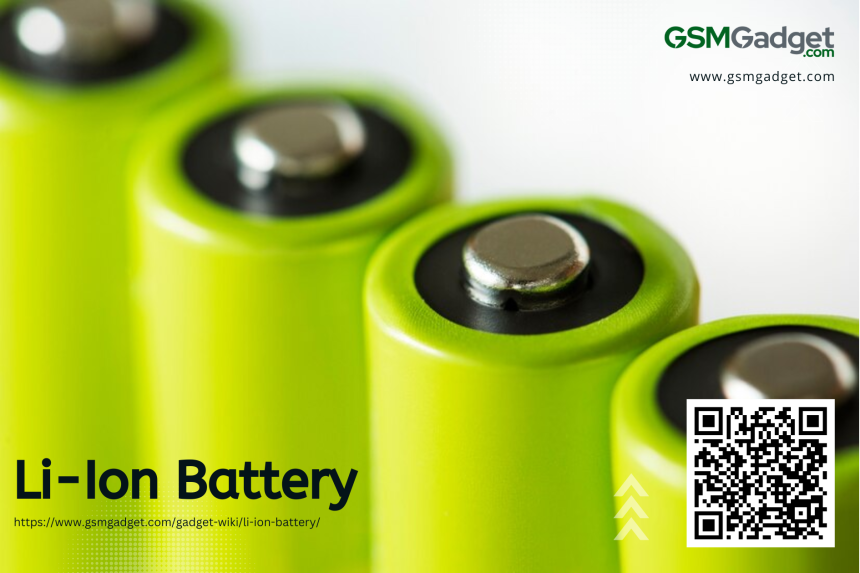A Lithium-ion (Li-ion) battery is a type of rechargeable battery that’s used in lots of devices, like smartphones and electric cars. It’s popular because it can store a lot of energy and is pretty light. When you charge or use the battery, lithium ions move between two parts called the cathode and anode through something called an electrolyte. People like Li-ion batteries because they last a long time, don’t lose their charge easily when not in use, and don’t have a memory effect, which means you can charge them without them losing their ability to hold a full charge. These batteries are really important for portable gadgets and help us use less energy from non-renewable sources. They’re great at keeping a charge and giving a lot of power for their size, making our on-the-go life easier and more efficient.
Specification Table of Li-Ion Battery
| Specification | Detail |
| Chemistry | Lithium-Ion (Li-Ion) |
| Nominal Voltage | 3.6V – 3.7V per cell |
| Typical Capacity | Varies (e.g., 1500mAh – 3500mAh per cell) |
| Energy Density | 150-250 Wh/kg |
| Charge Cycles | 300-500 before significant capacity decline |
| Charge Temperature Range | 0°C to 45°C |
| Discharge Temperature Range | -20°C to 60°C |
| Self-Discharge Rate | 1-2% per month |
| Max Charging Voltage | 4.2V per cell |
| Cut-off Voltage | 2.5V – 3.0V per cell |
| Power Density | Around 250-340 W/kg |
| Standard Charging Current | 0.5C to 1C (C=Capacity in Ah) |
| Max Charging Current | 1C or higher (varies by manufacturer) |
| Standard Discharge Current | 0.2C to 1C |
| Fast Charge Current | Up to 3C or higher, depending on the manufacturer |
| Max Discharge Current | Varies (e.g., 1C – 5C or higher) |
| Cycle Life
|
Around 300 to 500 cycles at 100% DOD (Depth of Discharge) |
| Cell Configuration | Single cell or multiple cells in series/parallel |
| Protection Circuit | Overcharge, over-discharge, short circuit, overcurrent |
| Terminal Type | Flat top, button top, or custom connectors |
| Dimensions | Varies (cylindrical cells are often 18650, 21700, etc., pouch and prismatic cells have variable dimensions) |
| Weight | Depends on cell size and capacity |
| Certifications | UL, CE, RoHS, UN38.3, IEC etc. |
| Lifecycle | Typically around 1000-2000 full cycles |
| Memory Effect | None |
| Environmental Impact | Contains toxic materials, recycling recommended |
| Operating Temperature Range | Charge: 0°C to 45°C
Discharge: -20°C to 60°C |
| Self-discharge Rate | Approximately 1-2% per month |
| Internal Resistance
|
Varies with construction and size, typically < 200 mΩ for small cells |
| Safety Features
|
Often include built-in PTC (Positive Temperature Coefficient), CID (Current Interrupt Device), and pressure relief vent |
| Typical Applications
|
Mobile devices, electric vehicles, energy storage systems, etc. |
| Charging Method | CC-CV (Constant Current – Constant Voltage) |
| Quality Control Standards | May adhere to ISO 9001, ISO 14001, etc. |
| Pack Configurations | Single cells, multi-cell packs, modules, or custom configurations |
| Protective Circuitry
|
May include PCM (Protection Circuit Module) to prevent over-charge, over-discharge, over-current, and short-circuit |
| Warranty
|
Typically ranges from 6 months to 2 years, depending on manufacturer and application |
Basic Components and Functioning of Li-Ion Battery
Li-ion batteries are key to today’s tech, running things like phones and electric cars. They have four main parts: the cathode, anode, electrolyte, and separator. These parts help lithium ions move when you charge and use the battery. This movement creates the electricity that makes our devices work.
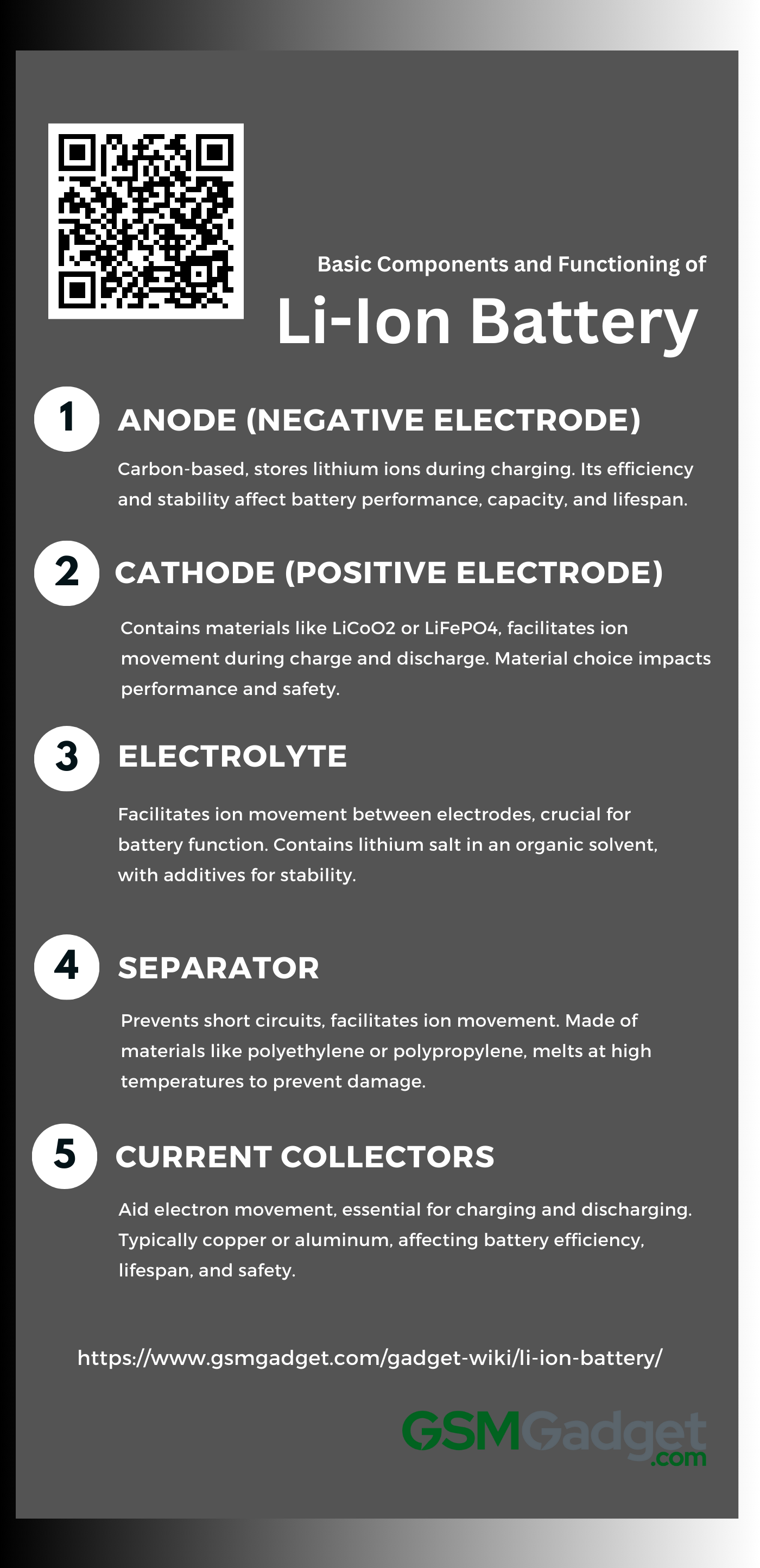
1. Anode (Negative Electrode)
The anode, or the negative side of a lithium-ion (Li-ion) battery, is super important. It’s made mostly from carbon stuff like graphite and holds lithium ions when you charge your device. When these ions go from the positive side (cathode) through a liquid (electrolyte) to the anode, they keep energy that turns into electricity when the ions move back to the cathode as you use your device. How well the anode can take in and let go of lithium ions, along with how strong it stays over time, really matters for how good the battery works, how much power it can hold, and how long it lasts.
2. Cathode (Positive Electrode)
The cathode, or the positive side of a lithium-ion (Li-ion) battery, is super important. It’s made of stuff like lithium cobalt oxide (LiCoO2) or lithium iron phosphate (LiFePO4), and it helps move lithium ions around when the battery charges and discharges. This movement of ions is key for the battery to work over and over again and give off power. The type of material used in the cathode can change how much voltage and capacity the battery has, as well as how safe and stable it is. That’s why scientists keep studying the cathode to make batteries better and suitable for different uses.
3. Electrolyte
The electrolyte in a lithium-ion (Li-ion) battery is super important. It helps move lithium ions from one side to the other when the battery charges and discharges. This special mix usually has a lithium salt like LiPF6, LiBF4, or LiClO4 in a liquid called an organic solvent, such as ethylene carbonate or dimethyl carbonate. The electrolyte does a lot: it lets ions move easily, keeps itself from breaking down, and isn’t too thick so there’s less resistance. It also has special additives that protect the electrodes, which makes the battery last longer and be safer. So, the stuff that’s in the electrolyte really matters for how well the battery works, how safe it is, and how long it lasts.
4. Separator
The separator in a lithium-ion (Li-ion) battery is super important for safety. It has two big jobs: it keeps the cathode and anode apart to stop short-circuits, and it lets lithium ions move around when the battery charges and discharges. This part is made of a thin, holey material like polyethylene (PE) or polypropylene (PP). It’s strong, stable, and can handle heat well. The holes in the separator are made just right to let ions pass through easily without creating too much electrical resistance. If the battery gets too hot, the separator melts on purpose to stop the ions and keep the battery from getting damaged. This makes sure the battery works well, lasts long, and stays safe.
5. Current Collectors
In lithium-ion (Li-ion) batteries, current collectors are key parts of the electrode structure. They help move electrons during charging and discharging. The anode and cathode current collectors are usually made from copper and aluminum because they conduct electricity well and can handle the battery’s chemical conditions. These parts provide a solid base for the active material and make sure the current spreads out evenly. This is super important for good ion exchange and saving energy. The design and strength of current collectors are really important. They affect how well the battery works, its energy storage, and its safety. They have to withstand the wear and tear of normal use. Making them better can lead to more efficient charging and longer battery life. Also, how they interact with other parts of the battery, like the electrolyte, is something scientists are looking into. They want to stop wear and tear and make batteries safer and last longer.
Advantages of Li-Ion Batteries
Li-ion batteries are super important in today’s tech world. They power tons of stuff, from our phones to electric cars. They’re known for packing a lot of energy and lasting a long time, which makes them really efficient and tough. Let’s look at some big reasons why Li-ion batteries are the go-to option for lots of gadgets.
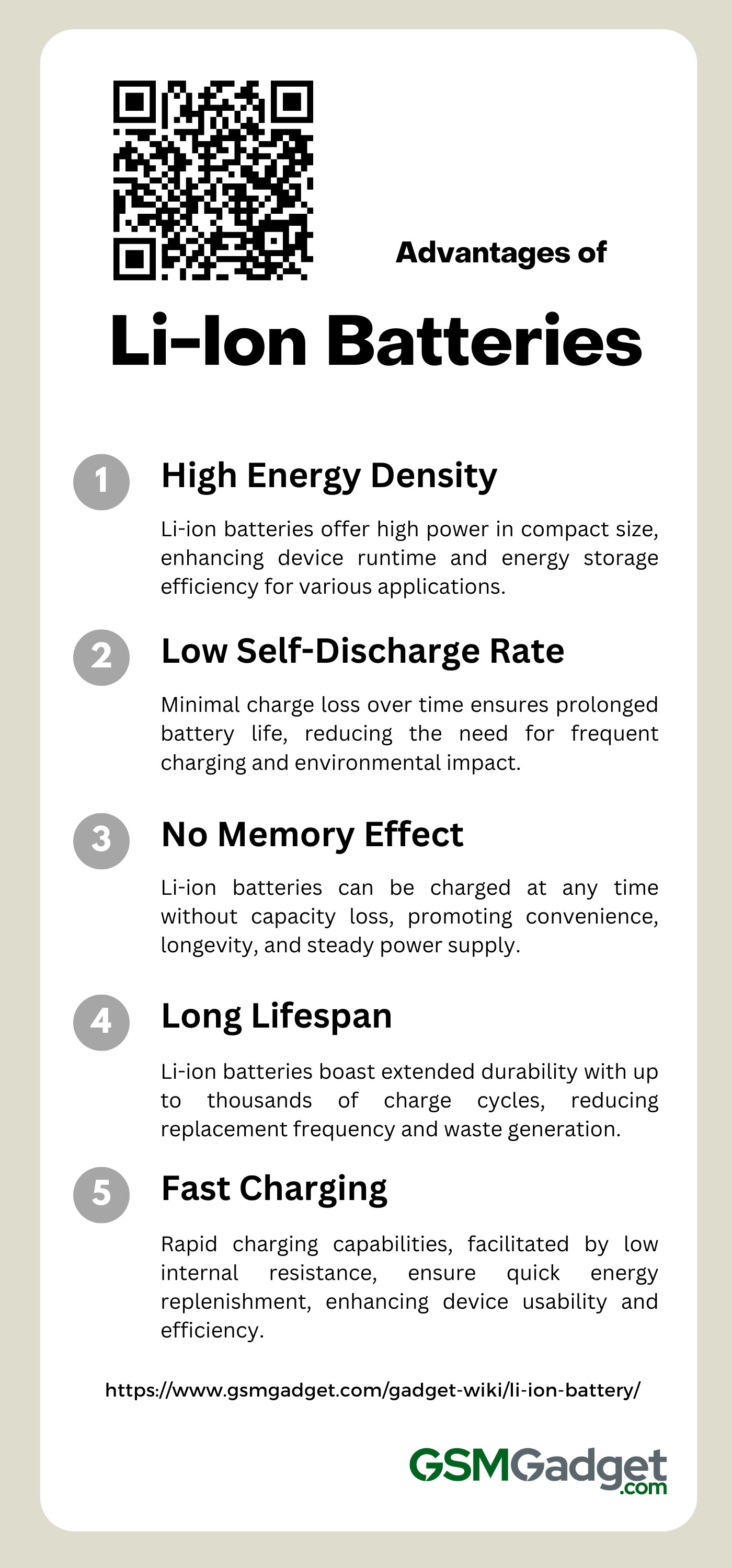
1. High Energy Density
Li-ion batteries are popular because they pack a lot of power for their size and weight. They have energy densities between 260 and 270 Wh/kg, which means they can store lots of energy without being bulky. This is great for keeping devices like smartphones and electric cars running longer between charges. Plus, their small and light design is perfect for making electronics smaller and improving how we store energy. These batteries keep getting better, helping us meet the demand for powerful and efficient energy storage.
2. Low Self-Discharge Rate
Lithium-ion (Li-Ion) batteries shine in today’s tech because they lose very little charge over time. They typically drop only about 1.5-3% of their charge each month. This is much less than nickel-cadmium (NiCd) batteries, which can lose up to 15-20% in the same period. This low self-discharge rate is key for Li-Ion batteries’ long life and efficiency. It means devices like smartphones, laptops, and electric cars stay charged longer, even when not in use. With fewer charges needed, these batteries last longer. This saves money and is better for the environment. That’s why Li-Ion batteries are now the top choice for many electronic devices. They give users reliable power and more convenience.
3. No Memory Effect
Lithium-ion (Li-Ion) batteries have a big plus: they don’t get the memory effect. This means you can charge them anytime without hurting their full power. They’re different from nickel-cadmium batteries that need to be fully drained to keep their energy up. Because you can charge Li-Ion batteries often and just a little bit at a time, it’s more convenient and helps them last longer. This is good because it avoids the wear and tear of full charging cycles. So, Li-Ion batteries give steady power and don’t need to be charged as often. They’re perfect for today’s gadgets and electric cars that we plug in a lot. This makes our devices last longer and is better for the planet too.
4. Long Lifespan
Lithium-ion (Li-Ion) batteries are known for their long life, which is a big plus in the world of rechargeable batteries. They often give you 500 to 2000 charge cycles. Some high-end types, like LiFePO4, can handle up to 15,000 cycles. This means they could last over ten years with normal use. Their longevity comes from their high energy density and their ability to hold a charge for a long time when not used. As Li-Ion technology gets better, these batteries last even longer. They’re the top choice for many devices, from smartphones to electric cars. Li-Ion batteries are convenient for users and save money because you don’t have to replace them often. They also help the environment by cutting down on waste.
5. Fast Charging
Li-ion batteries are known for their super-fast charging, which is perfect for our busy world. They charge way faster than nickel-based ones, often getting to 80% in just a few minutes. This happens because they have low internal resistance, and the lithium ions move quickly between the anode and cathode. Plus, they can handle more current without much wear. New tech like Aligned Graphite® has made them even better at charging fast, showing that Li-ion technology keeps getting better to meet our need for quick energy boosts. As a result, gadgets like smartphones and electric cars don’t have to be down for long. They’re ready to go again quickly, which is what we all want.
Applications of Li-Ion Batteries
Li-ion batteries are key for today’s portable power. They run lots of devices because they pack a lot of energy and last long. Many industries use them because they’re so handy and work well. Here’s a look at where Li-ion batteries are really making a difference.
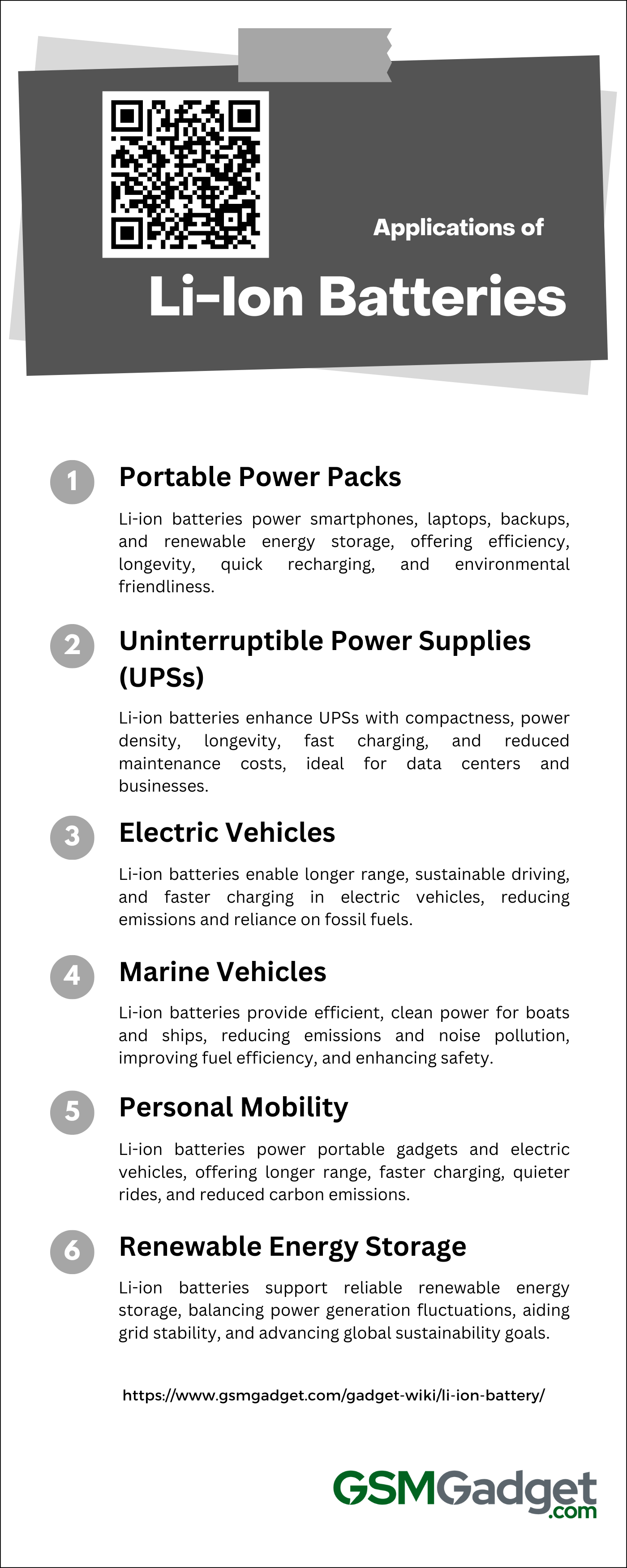
1. Portable power packs
Lithium-ion (Li-Ion) batteries have changed how we use portable power. They pack a lot of energy into a small, light package, making them great for on-the-go gadgets. We rely on them for many things, like our phones, laptops, emergency backups, and storing renewable energy. Li-Ion batteries are efficient, long-lasting, and keep a steady power level. They also don’t lose their charge when not in use. With the ability to recharge quickly and less harm to the environment, they’re the top choice for everyday tech and big industries. This fits well with the growing focus on being eco-friendly in technology.
2. Uninterruptible Power Supplies (UPSs)
Lithium-ion (Li-ion) batteries have changed the game for Uninterruptible Power Supplies (UPSs). They’re smaller, lighter, and pack more power, which is perfect for keeping things running smoothly in places like data centers, hospitals, and phone companies. These batteries charge fast, last up to three times longer than old-school lead-acid ones, and can handle heat better. This means less upkeep and a lower cost over time. Plus, their slim design is great for saving space, which really helps in small data centers. Even though they cost more at first, Li-ion batteries are worth it in the long run. They offer reliable backup power and are a smart pick for today’s UPS systems across all sorts of businesses.
3. Electric vehicles
Lithium-ion (Li-ion) batteries are key to electric vehicles (EVs). They pack more power and last longer than older batteries. This means EVs can go farther without needing a charge, easing worries about running out of power. Li-ion batteries also hold their charge longer when not in use. They’re good at turning energy into power and can be charged and used many times. This makes EVs more sustainable and cost-effective. With faster charging and longer ranges, Li-ion batteries help reduce air pollution and cut down on oil use. As the EV world grows, Li-ion tech leads the way, pushing for cleaner and better ways to get around.
4. Marine vehicles
Lithium-ion (Li-Ion) batteries are leading a big change in the marine industry. They offer high energy and efficiency, making them great for powering boats and large ships. Their light and small design is perfect when space and weight matter a lot. Li-Ion batteries are also cleaner and quieter than diesel engines, cutting down on emissions and noise, which helps marine life. They can work with regular engines in hybrid systems to save fuel. Plus, they charge fast and last a long time, so boats and ships can rely on them. Safety features like temperature control and protection circuits make them even better for the tough conditions at sea. As technology gets better, we’ll see more Li-Ion batteries in the marine world, making it cleaner and more efficient.
5. Personal mobility
Li-ion batteries have changed the way we move. They’re light, pack a lot of power, and are perfect for all sorts of portable gadgets, like phones, laptops, and smartwatches. Plus, they’re key to the electric vehicle trend, powering scooters, bikes, skateboards, cars, and motorcycles. These batteries let us go further on one charge—imagine scooters going over 50 miles—and they charge up fast. This means less waiting and better commutes in cities. Not only do they make our rides quieter and smoother, but they also help the planet by cutting down on carbon emissions. By moving away from old-school fossil fuels, we get a cleaner choice. Li-ion batteries keep pushing new ideas in how we get around, leading us toward a future where travel is clean, easy to get to, and good for the environment.
6. Renewable energy storage
Lithium-ion (Li-ion) batteries are key in making renewable energy like solar and wind more reliable. They store a lot of energy, work efficiently, and last long. These batteries can charge and discharge quickly and keep going for many cycles. This helps even out the ups and downs in power generation, giving us a steady and dependable energy supply. As we push for more green energy, Li-ion batteries are becoming a big part of smart grids, home storage, and big utility projects. They help us use more renewable energy. Plus, they’re getting cheaper and can be made bigger or smaller as needed. A good example is the Hornsdale Wind Farm in South Australia. It shows how these batteries can help keep the power grid stable and move us toward an energy system that doesn’t rely on carbon. As Li-ion technology gets better, it’s expected to play a huge role in meeting global sustainability goals. It does this by making sure we can blend renewable energy smoothly into our power systems.
Safety and Performance Issues of Li-Ion Battery
Lithium-ion (Li-ion) batteries are key to today’s tech, running things like phones and electric cars. But they have some issues, such as safety and performance problems in certain situations. We’ll look at the main worries with Li-ion batteries, like getting too hot, losing charge over time, and the danger of short circuits.
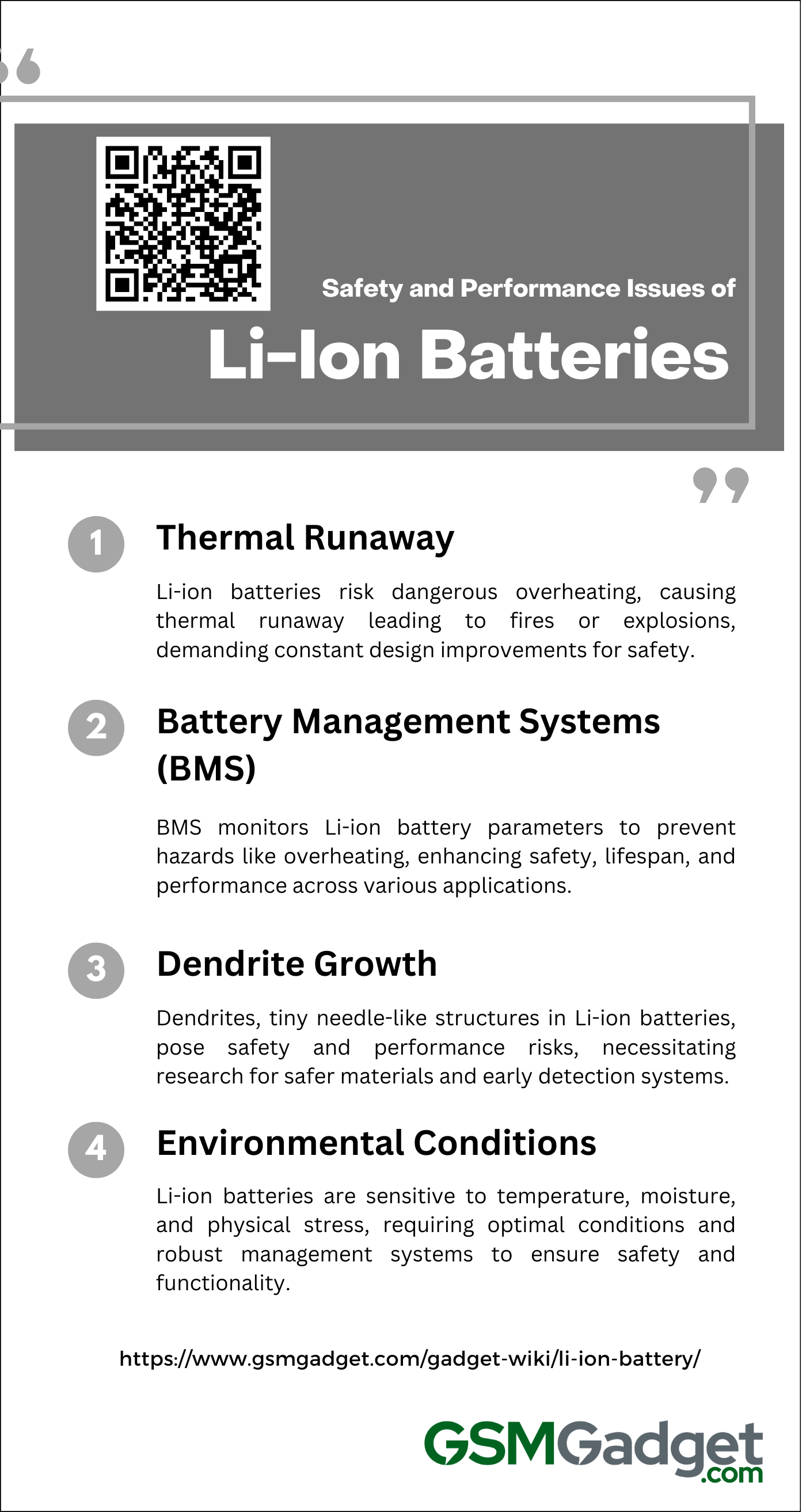
1. Thermal Runaway
Lithium-ion (Li-ion) batteries are key to our tech today, but they have big safety and performance issues. One serious problem is thermal runaway. This happens when they get too hot, causing a dangerous chain reaction. It can be caused by things like internal short circuits, damage, overcharging, or too much heat from outside. When this happens, the temperature shoots up fast, which can lead to fires, explosions, and harmful gases being released. Even though these batteries have safety parts like separators and systems to manage heat, they can still fail if conditions are really bad or if there’s a mistake in how they’re made. That’s why it’s super important to keep improving battery design and materials. We need to stop thermal runaway to make sure Li-ion batteries are safe and work well for all sorts of things, like our gadgets and electric cars.
2. Battery Management Systems (BMS)
Lithium-ion (Li-ion) batteries are key to today’s tech, powering everything from phones to electric cars. But they can be risky. Too much heat can cause thermal runaway, which might lead to fires or explosions. This can happen if there’s a short circuit, damage, overcharging, or too much outside heat. Battery Management Systems (BMS) help keep these risks low. They watch and control things like temperature, voltage, and current. This keeps the battery safe and makes it last longer. Even with safety parts like separators and ways to manage heat, batteries can still fail if conditions are really bad or there are flaws from when they were made. A good BMS also protects against hackers, keeps cells working together well, and checks how full the battery is (SOC) and how healthy it is (SOH). These checks are important to make sure the battery works its best. Still, since thermal runaway is a real danger, we need to keep making BMS better. This will help Li-ion batteries be safer and more reliable for all their uses.
3. Dendrite Growth
Dendrite growth in lithium-ion (Li-ion) batteries is a big problem. It affects safety and how well the batteries work. Dendrites are like tiny needles that can grow on the anode when you charge and discharge the battery. If we don’t deal with them, they might poke through the separator between the anode and cathode. This can cause short circuits and even make the battery catch fire or explode. Plus, it can make the battery’s capacity and life shorter. To make Li-ion batteries safer and last longer, researchers are working hard. They’re looking for better materials for electrodes, new mixes for electrolytes, and smarter designs for batteries. It’s also important to have systems that can watch for dendrites and take care of them early on. All this work helps make Li-ion batteries more reliable and safe for all the tech we use every day.
4. Environmental Conditions
Li-ion batteries are key for things like smartphones and electric cars, but they’re really sensitive to the weather. If it gets too hot, they could overheat or even catch fire. If it’s too cold, they won’t work as well and take longer to charge. Wet conditions aren’t good either because they can break down parts of the battery, making it less powerful and more likely to get damaged. Shaking and bumps can also mess up how the battery works. To keep these batteries safe and working right, we need to keep them in the best conditions and use strong battery management systems. This way, we can rely on our Li-ion batteries to do their job safely.
Drawbacks of Li-Ion Battery
Lithium-ion batteries are well-liked because they pack a lot of power and work efficiently. But, they have some big downsides. They can overheat, they only last for so many charges, and they cost a lot to make. Let’s look closer at these issues.
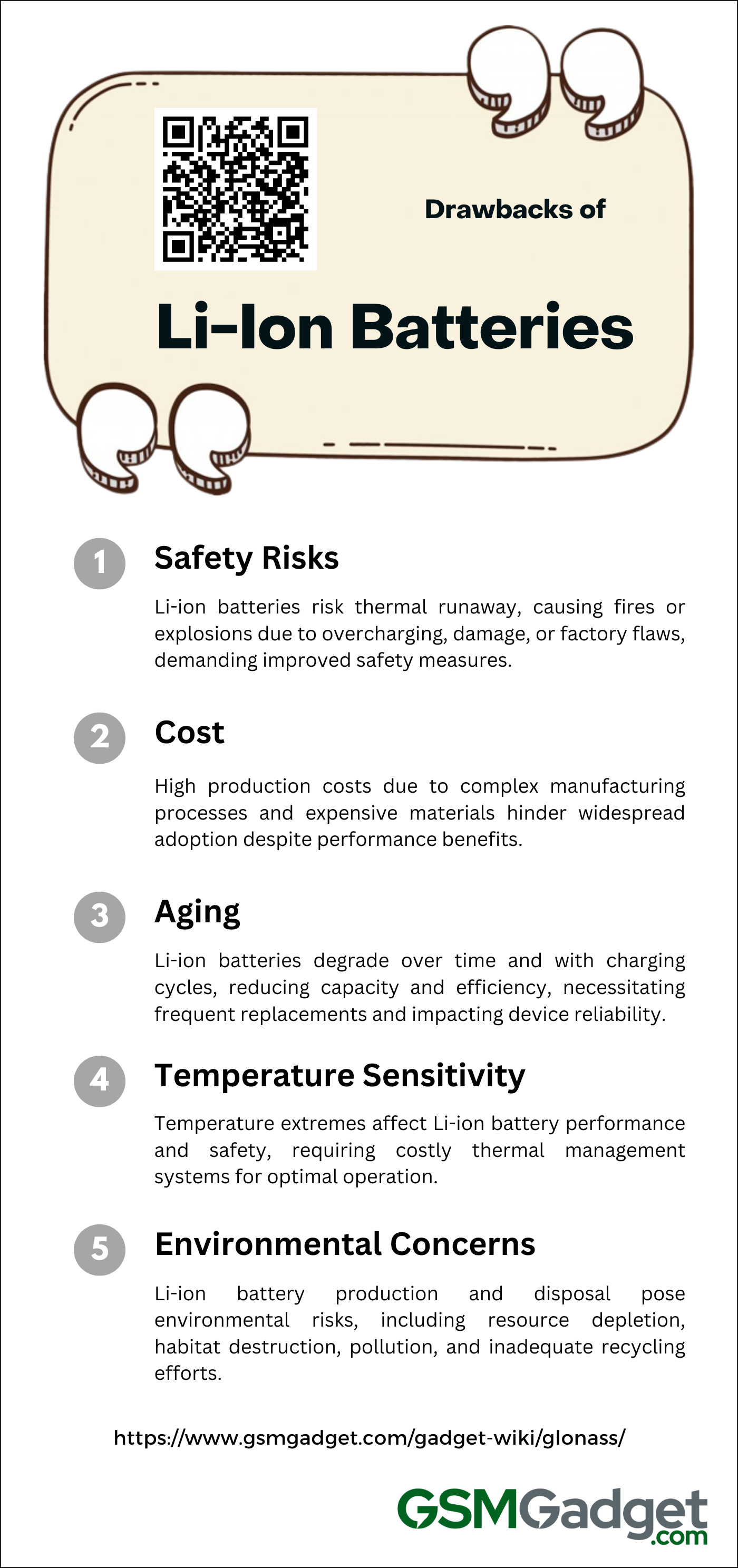
1. Safety Risks
Lithium-ion (Li-Ion) batteries pack a lot of power and can be recharged, but they also have safety risks. The main worry is thermal runaway, where the battery gets so hot it starts a heating cycle that might cause fires or explosions. This can happen if you overcharge the battery, drain it too much, damage it, or if there’s a flaw from the factory. To keep things safe, batteries have special circuits, temperature controls, and strong materials. But even with these, accidents can still happen. That’s why it’s super important to follow safety rules and handle batteries with care. Since Li-Ion batteries can be dangerous, as shown by reports of fires, we need more research to make them safer.
2. Cost
The high price of lithium-ion (Li-Ion) batteries is a big problem. It comes from the tricky way they’re made and costly materials like lithium, cobalt, and nickel. These materials are not just expensive; their prices can change a lot and are affected by global politics. Making these batteries needs careful control of the environment, advanced machines, and strict safety steps, which all add to the cost. This makes it hard for them to be used more in big energy storage projects and in gadgets where keeping costs down matters a lot. Even though Li-Ion batteries last longer and pack more power, they’re still expensive. People are working to make cheaper options, and prices are slowly getting better as technology advances and production grows.
3. Aging
Lithium-ion (Li-Ion) batteries are popular because they pack a lot of power and don’t need much upkeep. But over time, they do get old, which can mess with their performance and how long they last. There are two main types of aging: calendar aging, which happens over time, and cycle aging, which comes from charging and using the battery. After 500 to 1000 cycles, a battery might only have half of its original power left. Things like hot temperatures, overcharging, letting the battery get too low, and using a lot of power at once can make this worse. These issues can cause the battery to take longer to charge and not give as much power. Also, when the battery gets hot or is kept fully charged for too long, a layer called the solid electrolyte interphase (SEI) grows on the anode. This uses up some of the lithium and makes the capacity drop even more. Because of these issues, Li-Ion batteries need to be replaced more often than other kinds. This isn’t great for the environment and can make the devices they’re in less reliable. Even though there are new ways to slow down aging, it’s still a big problem for Li-Ion batteries. It affects how long they can be used and how cost-effective they are.
4. Temperature Sensitivity
Lithium-ion (Li-ion) batteries are popular because they hold a lot of energy and last long. However, temperature changes can really affect how well they work and how safe they are. When it gets too hot, chemical reactions inside the battery speed up. This can shorten the battery’s life and might even lead to overheating. In serious cases, this could cause fires or explosions. On the other hand, when it’s cold, the battery doesn’t work as efficiently and charging it could permanently damage it. Because of these issues with temperature, Li-ion batteries need special systems to control their heat. These systems help keep the batteries at a safe and ideal temperature, between 20 to 50°C. This is super important for all kinds of products, from smartphones to electric cars. But having these thermal management systems does make the batteries more expensive and complex.
5. Environmental Concerns
Lithium-ion (Li-ion) batteries power our gadgets and electric cars but they can harm the environment. Mining lithium and cobalt, key parts of these batteries, can cause water shortages, soil damage, and dirty air. This is a big problem in dry places like South America that have lots of lithium. The mining also destroys animal homes, raises ethical issues, and reduces the variety of living things. Making Li-ion batteries uses a lot of carbon and depends on energy sources that can run out. When these batteries are thrown away the wrong way, they can leak harmful chemicals into the ground and water. Even though we can recycle them, we’re not doing it well or often enough. With more people wanting Li-ion batteries, we need to manage their whole life cycle better and come up with new ways to recycle them. This will help reduce the damage they do to our planet.
